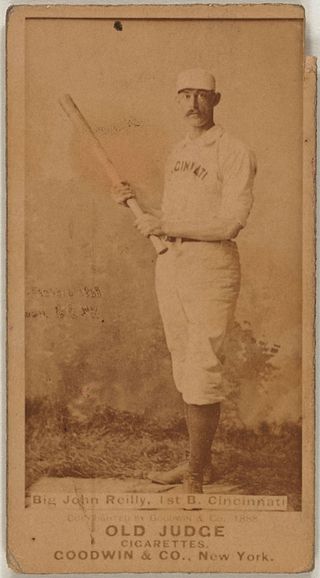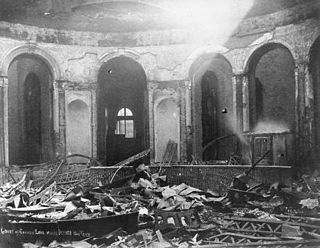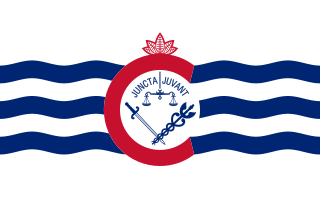
Lewis Wallace was an American lawyer, Union general in the American Civil War, governor of New Mexico Territory, politician, diplomat, artist, and author from Indiana. Among his novels and biographies, Wallace is best known for his historical adventure story, Ben-Hur: A Tale of the Christ (1880), a bestselling novel that has been called "the most influential Christian book of the nineteenth century."

James Monroe Cox was an American businessman and politician who served as the 46th and 48th governor of Ohio, and a two-term U.S. Representative from Ohio. As the Democratic nominee for President of the United States at the 1920 presidential election, he lost in a landslide to fellow Ohioan Warren G. Harding. His running mate was future president Franklin D. Roosevelt. He founded the chain of newspapers that continues today as Cox Enterprises, a media conglomerate.

Christmas seals are adhesive labels that are similar in appearance to postage stamps that are affixed to mail during the Christmas season to raise funds and awareness for charitable programs. Christmas seals have become particularly associated with lung diseases such as tuberculosis, and with child welfare in general. They were first issued in Denmark beginning in 1904, with Sweden and Iceland following with issues that same year. In little time they were and continue to be issued by various other countries. Christmas Seals were sometimes mistaken for Christmas stamps used for postage, prompting the US Post Office to adopt a policy requiring seals to be affixed on the reverse side of a postcard or envelope, but the policy was generally unfavorable and often ignored, ultimately resulting in its withdrawal. Christmas seals exist in several varieties, most notably those first issued by the Red Cross and later by the National Tuberculosis Association with its red double barred cross on the face of the seal. Other charitable seals have been issued by religions and social organizations worldwide. From the onset Christmas seals received much public acclaim and were soon sought after by collectors and postal historians.Today, as a collectable item, their monetary worth varies considerably.

The Cincinnati and Lake Erie Railroad (C&LE) was a short-lived electric interurban railway that operated in 1930–1939 Depression-era Ohio and ran between the major cities of Cincinnati, Dayton, Springfield, Columbus, and Toledo. It had a substantial freight business and interchanged with other interurbans to serve Detroit and Cleveland. Its twenty high-speed "Red Devil" interurban passenger cars operated daily between Cincinnati and Cleveland via Toledo, the longest same equipment run by an interurban in the United States. The C&LE failed because of the weak economy and the loss of essential freight interchange partners. It ceased operating in 1939.
The Cincinnati, Hamilton and Dayton Railway (CH&DR) was an electric interurban railway that existed between 1926 and 1930 in the U.S. state of Ohio. It was absorbed in 1930 into the new Cincinnati and Lake Erie interurban railway. In typical interurban fashion, it had its own right of way in open country, although this was often adjacent or parallel to a road. In cities and towns it operated on city streets. This included two and three car freight/express trains as well as passenger cars.

With God, all things are possible is the motto of the U.S. state of Ohio. Quoted from the Gospel of Matthew, verse 19:26, it is the only state motto taken directly from the Bible. It is defined in section 5.06 of the Ohio Revised Code and sometimes appears beneath the Seal of Ohio. The motto was adopted in 1959 and survived a federal constitutional challenge in 2001. The state maintains that it is a generic expression of optimism rather than an endorsement of a particular religion.

John Good Reilly, nicknamed "Long John", was an American first baseman in Major League Baseball who played for the Cincinnati Stars (1880) and the Cincinnati Red Stockings/Reds (1883–1891). In 1888, he hit 13 home runs with 103 RBI and a .321 batting average. During and after his baseball career, Reilly was a commercial artist for the Strobridge Lithographing Company.

Edward Henry Potthast was an American Impressionist painter. He is known for his paintings of people at leisure in Central Park, and on the beaches of New York and New England.

Cincinnati is a city in and the county seat of Hamilton County, Ohio, United States. Settled in 1788, the city is located in the northern side of the confluence of the Licking and Ohio rivers, the latter of which marks the state line with Kentucky. The population of Cincinnati was 309,317 in 2020, making it the third-most populous city in Ohio after Columbus and Cleveland, and 65th in the United States. The city is the economic and cultural hub of the Cincinnati metropolitan area, Ohio's most populous metro area and the nation's 30th-largest with over 2.265 million residents.
Bleistein v. Donaldson Lithographing Company, 188 U.S. 239 (1903), is a case in which the United States Supreme Court found that advertisements were protected by copyright. The case is now cited for the proposition that commercial speech can be protected by copyright.

The Red Devil was a high-speed interurban streetcar built by the Cincinnati Car Company for the Cincinnati and Lake Erie Railroad (C&LE) in 1929–1930. They saw service throughout Ohio in the 1930s. After the failure of the C&LE in 1939 they saw service with the Cedar Rapids and Iowa City Railway (CRANDIC) and the Lehigh Valley Transit Company. Several have been preserved.

The Cincinnati riots of 1884, also known as the Cincinnati Courthouse riots, were caused by public outrage over the decision of a jury to return a verdict of manslaughter in what was seen as a clear case of murder. A mob in Cincinnati, Ohio, United States, attempted to find and lynch the perpetrator. In the violence that followed over the next few days, more than 50 people died and the courthouse was destroyed. It was one of the most destructive riots in American history.

Rookwood Pottery is an American ceramics company that was founded in 1880 and closed in 1967, before being revived in 2004. It was initially located in the Over-the-Rhine neighborhood in Cincinnati, Ohio, and has now returned there. In its heyday from about 1890 to the 1929 Crash, it was an important manufacturer, mostly of decorative American art pottery made in several fashionable styles and types of pieces.
The coats of arms of the U.S. states are coats of arms, that are an official symbol of the state, alongside their seal. Eighteen states have officially adopted coats of arms. The former independent Republic of Texas and Kingdom of Hawaii each had a separate national coat of arms, which are no longer used.
The following is a timeline of the history of the city of Cincinnati, Ohio, USA.

The flag of Cincinnati is the municipal banner of the city of Cincinnati, Ohio, in the United States. The design was selected in an 1896 contest. It was formally adopted on June 15, 1940.

Historical coats of arms of the U.S. states date back to the admission of the first states to the Union. Despite the widely accepted practice of determining early statehood from the date of ratification of the United States Constitution, many of the original colonies referred to themselves as states shortly after the Declaration of Independence was signed on 4 July 1776. Committees of political leaders and intellectuals were established by state legislatures to research and propose a seal and coat of arms. Many of these members were signers of the Articles of Confederation, Declaration of Independence, and United States Constitution. Several of the earliest adopted state coats of arms and seals were similar or identical to their colonial counterparts.

The Wagner Manufacturing Company was a family-owned manufacturer of cast iron and aluminum products based in Sidney, Ohio, US. It made products for domestic use such as frying pans, casseroles, kettles and baking trays, and also made metal products other than cookware. Wagner was active between 1891 and 1952, and at one time dominated the cookware market, selling in Europe and the US. The purchasers of the company in 1952 continued the brand, and Wagner products were rarely manufactured after 1998. The brand's trademarks were sold, and the purchasing company closed in 2008. The original items are prized by collectors.

The Clydesdale Motor Truck Company was a motor company that existed from 1917 to 1939 with headquarters in Clyde, Ohio. Initially, they made military trucks for World War I. Military contracts continued to be a large part of their business after the war, but they also sold into many other markets: general haulage, farming, and specialized vehicles such as fire trucks. They survived the Wall Street Crash of 1929 and the Great Depression, but increasingly struggling, they were wound up in 1939.

The seal of Cincinnati is the official insignia of the city of Cincinnati, Ohio, in the United States. Adopted in 1819, the seal incorporates scales, a sword, and a caduceus. The seal is featured prominently in the flag of Cincinnati and the insignia of city agencies and institutions.















